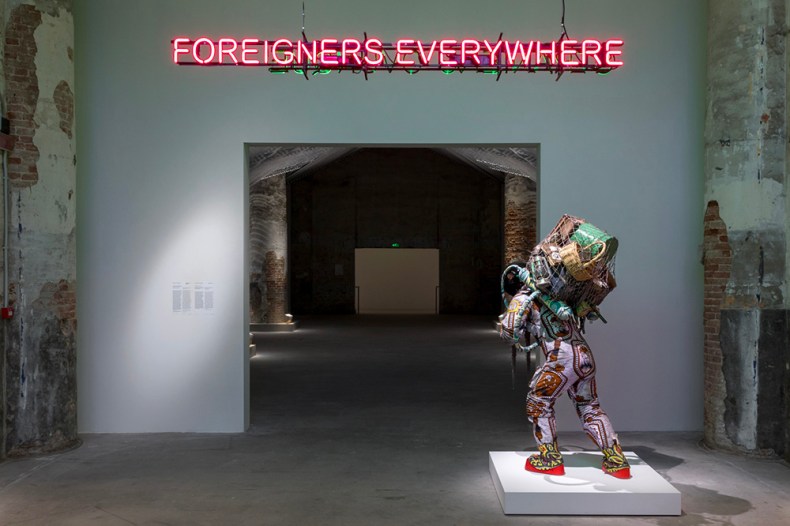Next year, the Kunsthaus Bregenz in Austria will stage an exhibition by a living artist whose identity will be kept secret for its entire duration. On the museum’s website, sandwiched between Małgorzata Mirga-Tas and a group show of work by Michael Armitage, Chelenge Van Rampelberg and Maria Lassnig (all well-known, well-regarded figures in the art world), is a line of black boxes, like a redacted name in a government document. According to the museum, the exhibition ‘will address the migration of ideas and the question of authorship’. We can’t yet know what this will look like in practice, but even in the abstract, the strategy feels potent right now. As viewers, we tend to orientate ourselves in our encounters with art through a set of metadata – age, gender, place of birth, ethnicity and so on – that shape, however subtly, our experience of looking. It’s undoubtedly the case that this data has accrued emphasis in the display, interpretation and perceived cultural value of the art of our time. What happens, then, when you take it away?
Something like this, perhaps. Picture yourself roaming the vast and cavernous halls of ‘Foreigners Everywhere’, the main exhibition at this year’s Venice Biennale, without any of the pointers provided by the wall labels, website or catalogue. What would it be like not to know an artist’s age, nationality or gender in that context? Enervating, exhausting, frustrating – or liberating? While hard to imagine in practice, it’s a worthwhile thought experiment, since ‘Foreigners Everywhere’ was notable for its curatorial emphasis on artists who’d often been excluded from Western art history on the basis of those very markers of identity. At the Biennale as a whole, the sheer abundance of artworks on show and the lack of time in which to engage with them properly often results in a kind of shorthand looking. The data points of identity often end up substituting for the rich encounter all artworks require. (Most of us are regretfully familiar with this). Replace Venice with Frieze, Art Basel, Documenta or any other environment in which we encounter art these days – even Instagram – and the implications of the Kunsthaus Bregenz exhibition become productively unsettling. The decision to anonymise an artist provides a chance to think through our dependence on the footholds of personal identity. To think critically about how we look at art – and what we get from it.
Installation view of Foreigners Everywhere (2004–) by Claire Fontaine and Refugee Astronaut VIII (2024) by Yinka Shonibare at the 2024 Venice Biennale. Photo: Mauro Zorzanello; courtesy La Biennale di Venezia

The Kunsthaus Bregenz exhibition is part of a long history of wilfully obscured authorship in the history of art. Banksy, Mark Rothko, Botticelli, Swoon, Man Ray, Lady Pink, Philip Guston, Parmigianino, Tom of Finland and Monster Chetwynd, to list a handful of prominent artists, disguise a given name with a pseudonym taken on for legal, practical or creative reasons. In most of these cases, a change of identity is the price of admission to a successful career. An assumed name, then, at once withholds the artist’s original identity and announces a desire to participate in the game. To withdraw any markers of identity, though, is something different, and such a move has its history too. The Bartleby-like preference not to participate in the conventions of the artist’s career path and to withdraw, to some extent, from the spotlight, is a position we might associate with artists of the later 20th century, like Stanley Brouwn, David Hammons or Lutz Bacher, as discussed in Martin Herbert’s brilliant book Tell Them I Said No (2016). The Kunsthaus Bregenz artist’s decision to withhold authorship is, in this sense, a bit of a throwback, but it’s one that takes on additional meaning in the world we inhabit now.
Anonymity is an invitation, too, of course. In the Curb your Enthusiasm episode ‘The Anonymous Donor’, the main character, Larry David (the alter ego of the show’s creator, Larry David), makes a large donation to a museum, which then names a wing after him, emblazoning his name on the wall in large letters. It is revealed that another individual also donated a large sum to the museum – but this is indicated by a sign reading ‘Donated by Anonymous’. Discovering that the true identity of this donor is in fact widely known – it’s Ted Danson, played by Ted Danson – David is incensed, seething: ‘It’s fake philanthropy, and it’s faux anonymity!’ Whether the identity of the anonymous artist is made public at any stage, there will be plenty of voices expressing similar disdain. Being in on the joke is one of the art world’s consolation prizes for its underpaid inhabitants, after all. Regardless, the ‘question of authorship’ the exhibition seeks to explore has already been addressed. Anonymity is a way of taking back control of the metadata of the public persona. It embodies a resistance to a tendency to flatten and reduce individuals to essential markers of identity. It says no.
The Kunsthaus Bregenz in Austria, which will host an exhibition of work by an anonymous artist next year (11 October 2025–18 January 2026). Photo: Markus Tret; © Kunsthaus Bregenz




